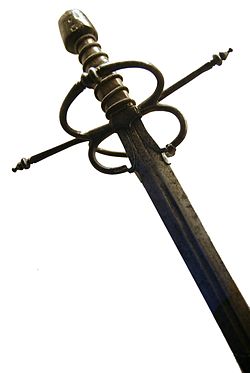Side sword
| Side sword | |
|---|---|

|
|
| Information | |
| Weapon type: | Sword, one-handed |
| Designations: | Lateral sword, riding sword, Spada de Lato |
| Use: | Military and civil weapon |
| Creation time: | 15th century |
| Working time: | until the 17th century |
| Region of origin / author: |
Italy |
| Distribution: | Europe |
| Overall length: | approx. 100 cm |
| Blade length: | approx. 80 cm |
| Weight: | approx. 1000 g |
| Lists on the subject | |
The side sword (from Italian Spada da Lato ), often equated with the riding sword , is a slim one-handed sword originating from Italy , which forms an intermediate form in the development from the medieval sword to the stitch-optimized rapier .
In military use, the side sword, which is more useful due to its ability to cut (or here often referred to as the riding sword or field rapier), was long held alongside the rapier, which was primarily a civilian weapon.
The side sword is characterized by a comparatively slim blade and a more complex parry compared to a medieval sword . Usually, in addition to the obligatory cross bar, there are various combinations of additional elements such as finger rings , parrying rings , blade bars and fist bars . Compared to the later rapiers, the vessels are much less complete. The blade is also not as long, narrow and stitch-optimized as the rapier. A side sword blade is sharpened and still well suited for the cut.
Accessories are also known from rapier fencing . Above all, the parrying dagger , but also buckler , targe , rotella and coat were used.
Fighting with two side swords - one in each hand - was extremely rare. Formative fencing masters with regard to the side sword were primarily Achille Marozzo (Opera Nova, 1536) and Antonio Manciolino (1531). The fencing system described by the Strasbourg free fencer Joachim Meyer, referred to as "Rappir" by himself, can also be classified as a side sword.
Individual evidence
- ↑ Archived copy ( Memento from June 21, 2010 in the Internet Archive )
- ↑ Archived copy ( Memento from March 4, 2016 in the Internet Archive )
- ↑ http://www.hf-westfalen.de/fechten/fechtstile/13-deutsche-rapierschule